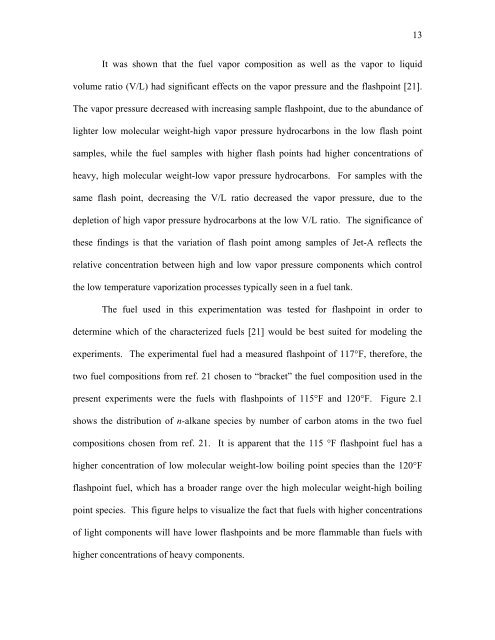Vaporization of JP-8 Jet Fuel in a Simulated Aircraft Fuel Tank ...
Vaporization of JP-8 Jet Fuel in a Simulated Aircraft Fuel Tank ...
Vaporization of JP-8 Jet Fuel in a Simulated Aircraft Fuel Tank ...
You also want an ePaper? Increase the reach of your titles
YUMPU automatically turns print PDFs into web optimized ePapers that Google loves.
It was shown that the fuel vapor composition as well as the vapor to liquid<br />
volume ratio (V/L) had significant effects on the vapor pressure and the flashpo<strong>in</strong>t [21].<br />
The vapor pressure decreased with <strong>in</strong>creas<strong>in</strong>g sample flashpo<strong>in</strong>t, due to the abundance <strong>of</strong><br />
lighter low molecular weight-high vapor pressure hydrocarbons <strong>in</strong> the low flash po<strong>in</strong>t<br />
samples, while the fuel samples with higher flash po<strong>in</strong>ts had higher concentrations <strong>of</strong><br />
heavy, high molecular weight-low vapor pressure hydrocarbons. For samples with the<br />
same flash po<strong>in</strong>t, decreas<strong>in</strong>g the V/L ratio decreased the vapor pressure, due to the<br />
depletion <strong>of</strong> high vapor pressure hydrocarbons at the low V/L ratio. The significance <strong>of</strong><br />
these f<strong>in</strong>d<strong>in</strong>gs is that the variation <strong>of</strong> flash po<strong>in</strong>t among samples <strong>of</strong> <strong>Jet</strong>-A reflects the<br />
relative concentration between high and low vapor pressure components which control<br />
the low temperature vaporization processes typically seen <strong>in</strong> a fuel tank.<br />
The fuel used <strong>in</strong> this experimentation was tested for flashpo<strong>in</strong>t <strong>in</strong> order to<br />
determ<strong>in</strong>e which <strong>of</strong> the characterized fuels [21] would be best suited for model<strong>in</strong>g the<br />
experiments. The experimental fuel had a measured flashpo<strong>in</strong>t <strong>of</strong> 117°F, therefore, the<br />
two fuel compositions from ref. 21 chosen to “bracket” the fuel composition used <strong>in</strong> the<br />
present experiments were the fuels with flashpo<strong>in</strong>ts <strong>of</strong> 115°F and 120°F. Figure 2.1<br />
shows the distribution <strong>of</strong> n-alkane species by number <strong>of</strong> carbon atoms <strong>in</strong> the two fuel<br />
compositions chosen from ref. 21. It is apparent that the 115 °F flashpo<strong>in</strong>t fuel has a<br />
higher concentration <strong>of</strong> low molecular weight-low boil<strong>in</strong>g po<strong>in</strong>t species than the 120°F<br />
flashpo<strong>in</strong>t fuel, which has a broader range over the high molecular weight-high boil<strong>in</strong>g<br />
po<strong>in</strong>t species. This figure helps to visualize the fact that fuels with higher concentrations<br />
<strong>of</strong> light components will have lower flashpo<strong>in</strong>ts and be more flammable than fuels with<br />
higher concentrations <strong>of</strong> heavy components.<br />
13
















